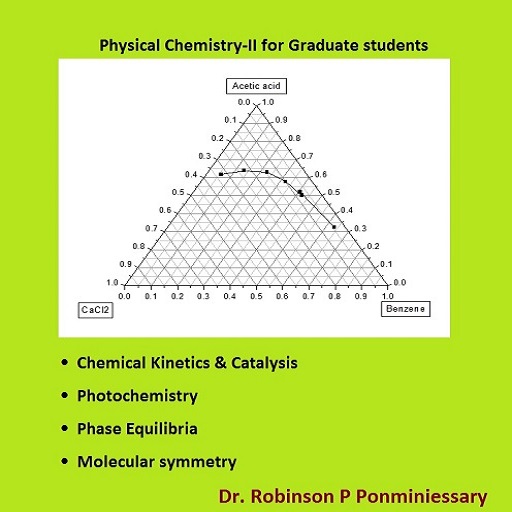
| Course Name | Chemical Kinetics |
| Course Subject | PHYSICAL CHEMISTRY |
| Course Code | OPENCH01 |
| Course Coordinator | Dr. Robinson P Ponminiessary |
| Course Category | Chemistry |
About Course
The branch of physical chemistry deals with application of the techniques and theories of physics and mathematics to the study of chemical systems. A proper training in Physical Chemistry will help a student to predict the kinetics of reactions by knowing the effect of temperature and catalysts. The present paper also deals with Photochemistry, the equilibrium between phases and Chromatography. When more than two phases are present, interesting applications arise with colloids and adsorption of gases on solids and liquids. The application of mathematical group theory to symmetry elements provides interesting outcomes - predict how a molecule interacts with electromagnetic radiation which is called a spectroscopy.
Prerequisites
Elementary ideas of Physical chemistry
Outcomes
Ideas of Physical chemistry
Course Syllabus
Lecture Notes
Introduction to Physical Chemistry
Chemists always deal with chemical reactions. Any chemical reaction involves movement of electrons. The movement may be from an atom to another atom, within a molecule or even it may be a movement within the molecular orbitals. The rate at which these electronic movements happens has profound influence in our daily life. Chemical kinetics which is an important branch of Physical Chemistry deals with the speed of these electronic movements or chemical reactions. The field of chemical kinetics evolved during the 17th century and is now a full-fledged branch of Chemistry. Chemical Kinetics deals with the rates of chemical reactions and with how the rates depends on factors such as concentration and temperature. Studies on Chemical kinetics helps an organic chemist to confirm the mechanistic studies, helps a chemical engineer to design an industrial reactor, helps a geologist to understand the flow processes and helps a medicinal chemist to know the drug interactions.
Reactions of different order
Chemists always deal with chemical reactions. Any chemical reaction involves movement of electrons. The movement may be from an atom to another atom, within a molecule or even it may be a movement within the molecular orbitals. The rate at which these electronic movements happens has profound influence in our daily life. Chemical kinetics which is an important branch of Physical Chemistry deals with the speed of these electronic movements or chemical reactions. The field of chemical kinetics evolved during the 17th century and is now a full-fledged branch of Chemistry. Chemical Kinetics deals with the rates of chemical reactions and with how the rates depends on factors such as concentration and temperature. Studies on Chemical kinetics helps an organic chemist to confirm the mechanistic studies, helps a chemical engineer to design an industrial reactor, helps a geologist to understand the flow processes and helps a medicinal chemist to know the drug interactions.
Lecture Videos
Physical Chemistry - Introduction
Basic theories of Chemical Kinetics
Chemical Kinetics- Problems 1
Numerical problems in chemical kinetics; Four problems and their solutions
Rate equations
Integrated rate equations for 1, 2, 3 and zero order reactions
Chemical Kinetics- Problems 2
Additional numerical problems on Chemical Kinetics
Practice Quiz
a) 1.331 mol L-1
b) 1.579 mol L-1
c) 1.231 mol L-1
d) 1.679 mol L-1
a) 16.12 min
b) 7.8 min
c) 8.7 min
d) 11.62 min
a) 0.846 mol dm-3
b) 0.426 mol dm-3
c) 0.246 mol dm-3
d) 0.486 mol dm-3
a) 75
b) 50
c) 25
d) 15
a) Activation energy = Average energy possessed by the reactant molecules – Threshold energy
b) Activation energy = Threshold energy – Average energy possessed by the reactant molecules
c) Activation energy = Threshold energy + Average energy possessed by the reactant molecules
d) Activation energy = Average energy possessed by the reactant molecules + Threshold energy
a) three
b) two
c) one
d) zero
a) Pseudo first order reaction
b) Second order reaction
c) Zero order reaction
d) Pseudo second order reaction
a) Mol L-1 s-1
b) L2 mol-2 s-1
c) L mol-1 s-1
d) L mol-1 s-2
a) 62.8
b) 52.8
c) 14.6
d) 23.5
a) 3
b) 0
c) 1
d) 2
a) 2
b) 1
c) 0
d) 3
a) 26.9
b) 92.6
c) 96.2
d) 62.9
a) 2.01 x 100000 dm3 mol-1 s-1
b) 5.65 x 100000 dm3 mol-1 s-1
c) 4.01 x 100000 dm3 mol-1 s-1
d) 2.89 x 100000 dm3 mol-1 s-1
a) rate = k [O3]2
b) rate = k [O3]2[O]1
c) rate = k [O]3
d) rate = k [O3]1[O]3
a) ln t(1/2) α T2
b) ln (t1/2) α T
c) ln t(1/2) α 1/T
d) ln t(1/2) α 1/T2









